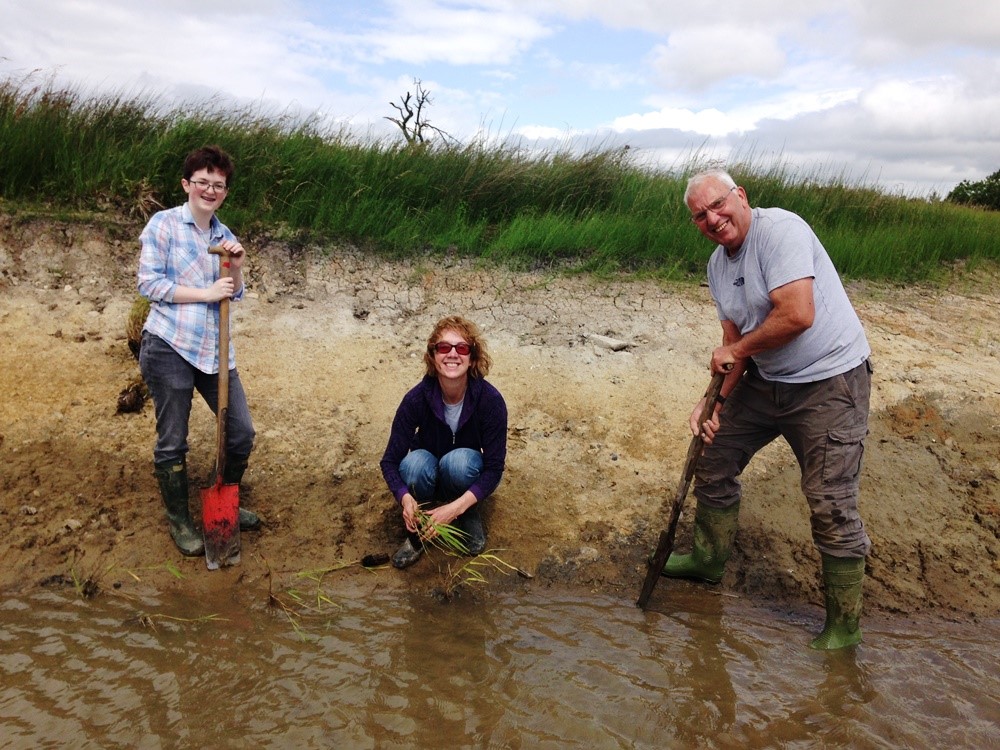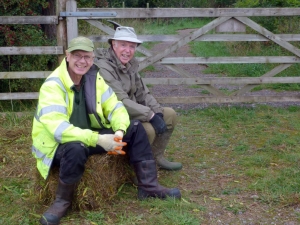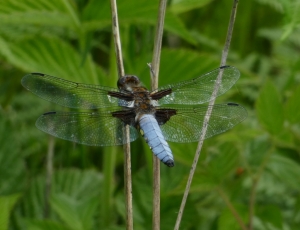Blog Archive (21) Posts Made in May 2019
All Creatures Bright and Beautiful
Wednesday, May 29th 2019
This male Bullfinch, unmistakable with his bright pinkish-red breast and cheeks and black cap, was feeding on a Dandelion flower seed head this morning.

Monitoring of nest boxes has continued on the reserve today with an unusual find in a box: a clutch of Wren chicks. Here is their artificial box which is hanging in one of the stores.

Two new Tawny Owl chicks were ringed from one of the large bird boxes in the woodland. They seem to be growing slowly maybe due to a lack of small rodents to feed on.

Lark and Taurus, with their summer coats now almost through, were busy grooming each other on their moorland patch!

Thank you to all of the Adopt-a-Box supporters and especially to Terry for providing some of the photographs for today's blog. All of the bird boxes have been checked now and the results will be compiled so that they can be sent out to all adoptees.
And finally, after several weeks of totally ignoring the new duck raft in the lake, a male Mallard was spotted sitting on it!

Good Growing Weather
Tuesday, May 28th 2019
Recent sunshine and rainfall has created perfect growing conditions for the vegetation. Although habitat maintenance is kept to a minimum during the summer months, it is still necessary to prune back growth alongside path edges, otherwise trails and views become lost! Blackthorn grows quickly and was starting to fill in the view of the fallen tree in the lake from the easy access route. Volunteers began their day by carefully weeding it out.
Many wheelbarrow loads were taken to the main track and removed by trailer. It started as a 'small pruning job' but turned out to be a much bigger task!

In between heavy showers, volunteers also filled bird feeders, helped to unload a delivery of bird seed sacks and strimmed along trails. Further pruning was required where rain had caused branches to fall over the pathways.

Throughout the day, the plaintive cry of the Buzzard could be heard as it soared overhead in dramatic grey skies. It appears to be in moult with several feathers missing from one wing.
Closer to the ground a cinnabar moth was observed at the lake edge and hundreds of froghoppers. These are small colourful insects that spring quickly when disturbed. Some species of these invertebrates start out in life as a tiny bug surrounded by foam (commonly named cuckoo spit). However, this particular one does not!
Scientists are calling for thousands of volunteers to help record sightings of spittle (the foam) and spittlebugs across the UK. The information will be used to map the distribution of the insect, in a pre-emptive strike against a deadly plant disease which may eventually threaten native species such as Oak trees. You can take part in the survey about xylem feeding insects by filling out an online form.

Out and About
Monday, May 27th 2019
Whilst out bird ringing there are fantastic opportunities for bird watching too. This photograph of a Peregrine Falcon was captured by John recently and when enlarged it appears to be wearing a metal BTO ring.

Earlier today, on a round of nest boxes in a woodland, this Tawny Owl was observed roosting in a Sycamore tree.
The first Oystercatcher chicks were ringed over a week ago out on the training area and already the distinguishing bright orange was beginning to show on their bills!

Many Lapwing chicks have also been ringed and for the first time this year two were ringed on the reserve itself.
Finally, Elizabeth observed a new species for Foxglove today at Spigot Mere; a Shelduck!

Flowers and Insects
Sunday, May 26th 2019
Almost daily flowers are opening and the invertebrate populations are appearing. The middle moor has been green but now there is colour across it. Yellow as the Yellow Rattle opens,

and the Meadow Buttercups. Once the flowers open so the insects arrive. This one, as yet un-named, was covered in pollen sheltering from the wind, deep inside the flower.

It is important to have several clovers for the different bee species we have recorded. Red, Zig Zag and White clovers grow throughout the reserve. Red Clover is the first to flower and there are hints of pink across the middle moor.
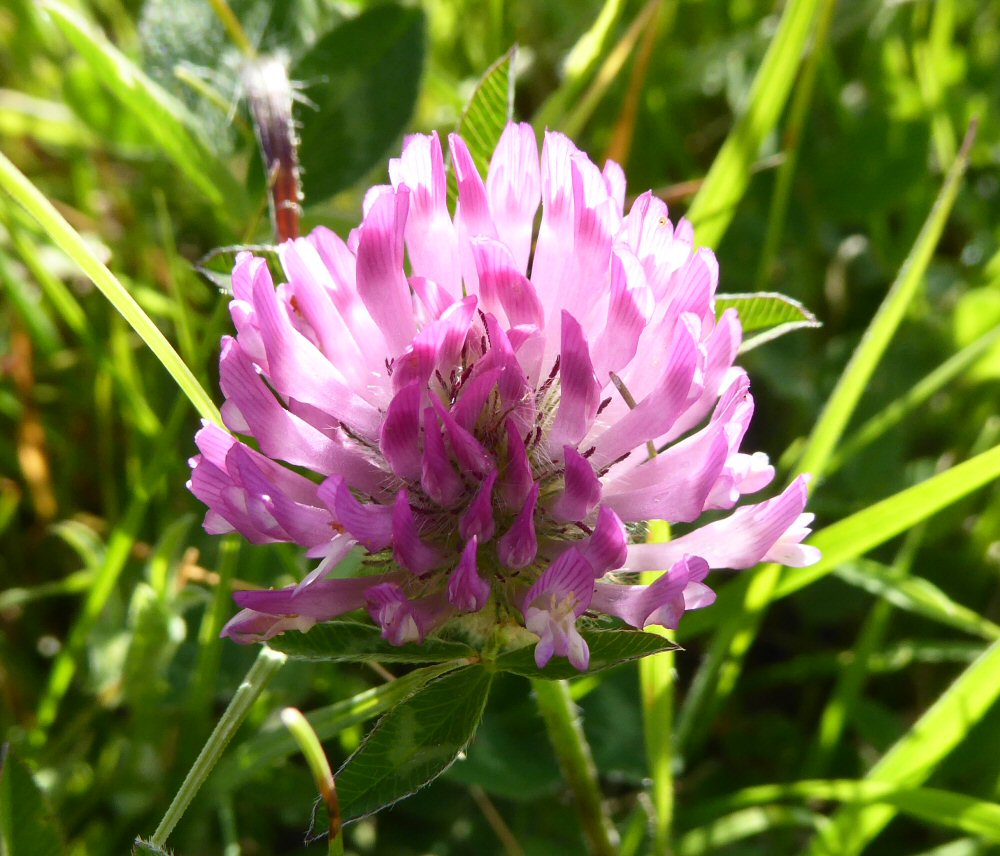
Wild Strawberry was once found in a small sheltered part along Risedale Beck but it is showing its white flowers in many more areas of the reserve now. These tiny micro moths, Micropterix calthella, usually associated with feeding on pollen from buttercups, were enjoying the open flowers.

House Martins were calling and feeding as they skimmed Spigot Mere, but then landed on the far bank, where some water was leaking into the Mere. They were collecting mud for nest building. Camera as usual was at full zoom!

The winter seed crop area has been ploughed and planted. Hopefully the forecast rain will encourage germination. Although the crop is aimed at birds, bees, butterflies and many other insects utilise the flowers as they grow.

Breeding Birds
Saturday, May 25th 2019
For the Swaledale Ringing Team it is the busiest time of the year as there are over 500 nest boxes to check and monitor. Some of these are large boxes designed for raptors and so far several have been found to have Tawny Owls nesting in them. These are one of the first owls to breed. This young owlet is one of many to be ringed this year although there are significantly less than in previous years which could be due to a food shortage.
Barn Owls are also ringed on various sites. Their young hatch later than the Tawny owls and so hopefully photographs of these will follow soon. Kestrel prefer the large boxes with an open front and their young hatch before the Barn Owls.

Inevitably, some of the remaining boxes are home to Jackdaws who adorn their homes with the most peculiar of items. In the past playing cards and cigarette ends have been discovered in amongst the twigs and sheep wool. However, this year, one of the boxes at Foxglove contained the top part of a smoke grenade! These are the chicks from this interesting nest which featured on an earlier blog just as they were hatching.
In the smaller boxes some of the birds have already fledged whilst others are still too small to be ringed such as this clutch of Blue Tit chicks that were checked today.
The nest boxes are sited all over the reserve; staff and volunteers have been to every corner in search of them! It can be quite an adventure going off the beaten track but the sights are amazing and well worth the effort!
Open nests are surveyed too where possible and a highlight is a local Dipper nest. These chicks were ringed before being carefully returned to their mossy abode beneath a bridge.
The information about all of these nests is passed on to the BTO who collect all of the data. However, the main study of breeding birds is the CES (Constant Effort Sites) bird ringing programe. It was the third day of this for 2019 and as expected the mist nets were quiet with most birds still on eggs or young. The main species ringed today were Blackcap, Garden Warbler, Chiffchaff and Willow Warbler. The first juvenile Chaffinch of the year was caught and ringed. The day was a success thanks to the bird ringers and scribe and to the volunteers who prepared the net rides by mowing and strimming and filling bird feeders.
Sweep Netting in the Sunshine
Thursday, May 23rd 2019
Pupils from Hipswell C of E Primary School have been exploring and learning about the wildlife on the reserve this week. Reception, Year One and Year Two all did some pond dipping, enjoyed a habitat walk and went on a 'Minibeast Safari'. The sunny spells were perfect for a bit of sweep netting on the hay meadow.

When the net contents were emptied into the trays a main highlight was the 'Timothy Grass Bugs' which were abundant!

The really exciting finds were put into small clear pots for a closer look.

The budding entomologists soon became skilled at catching all kinds of creatures that were hiding in the grass. The time flew by!

This Fourteen Spot Ladybird was one of the best finds.

Later in the day, this stunning juvenile Broad Bodied Chaser (Dragonfly) was spotted close to the outdoor classroom. Christine managed to get a fantastic photograph.

Thank you to everyone who helped out with the school visits and to Team Wednesday for identifying yet more species.
Sunny Days!
Wednesday, May 22nd 2019
The reserve is starting to look at its best with everything greening up.

Volunteers have been helping with monitoring bird boxes both on and off site. This involves visiting some beautiful Bluebell woods in the local area.

Pied Flycatchers still have eggs whereas many of the common birds such as Great Tits and Coal Tits have well developed chicks.

Team Tuesday repaired a footpath by the lake then gave some of the young trees on the reserve a bit of TLC in order to protect them from the prevailing wind and browsing deer.

As well as these jobs, volunteers also filled bird feeders, repaired the mobility scooter and led a guided walk, thank you to everyone for their hard work!

CES 2
Sunday, May 19th 2019
Skies with a hint of pink greeted the bird ringers for CES 2.
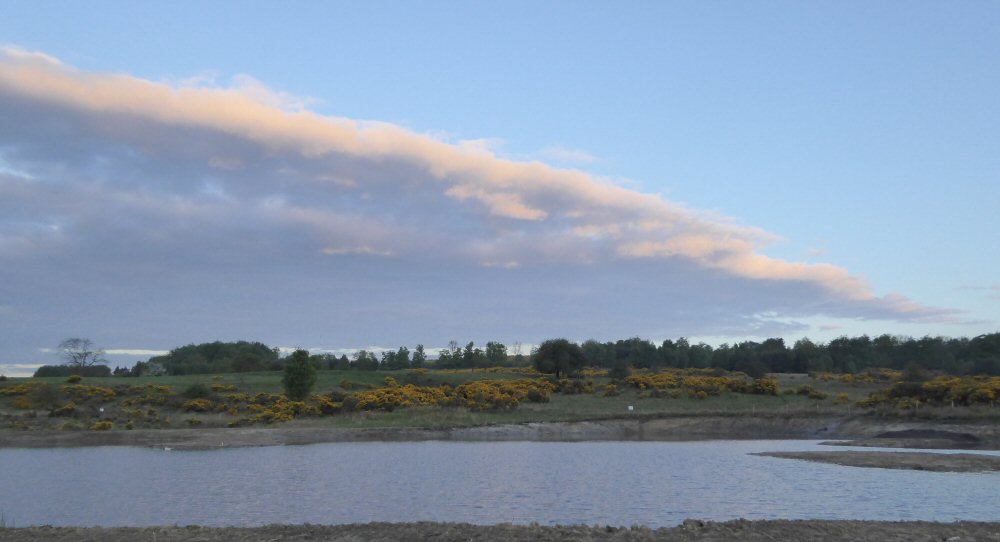
The same nets are raised on the same days for the same length of time, so data can be collected to enable comparisons and trends to be made. Unusually over 100 birds were processed. Last year for CES 2 there were only about 50.
Several Garden Warblers were ringed. More Bullfinches continued to arrive in the ringing room as did a 'whole flock' of adult and juvenile Long-tailed Tits. Blackcaps used to prefer the area of the reserve we call 'the bank' and were only caught there, but now they can be found in many different places.

The team effort ensured that the day went smoothly. Many thanks to everyone who helped.
This time of year sees new flowers in bloom almost daily. Cow Parsley only grows near the lake and is flowering.

One or two flowers of Common Bird's-foot Trefoil are open and soon areas of the moorland will turn yellow.
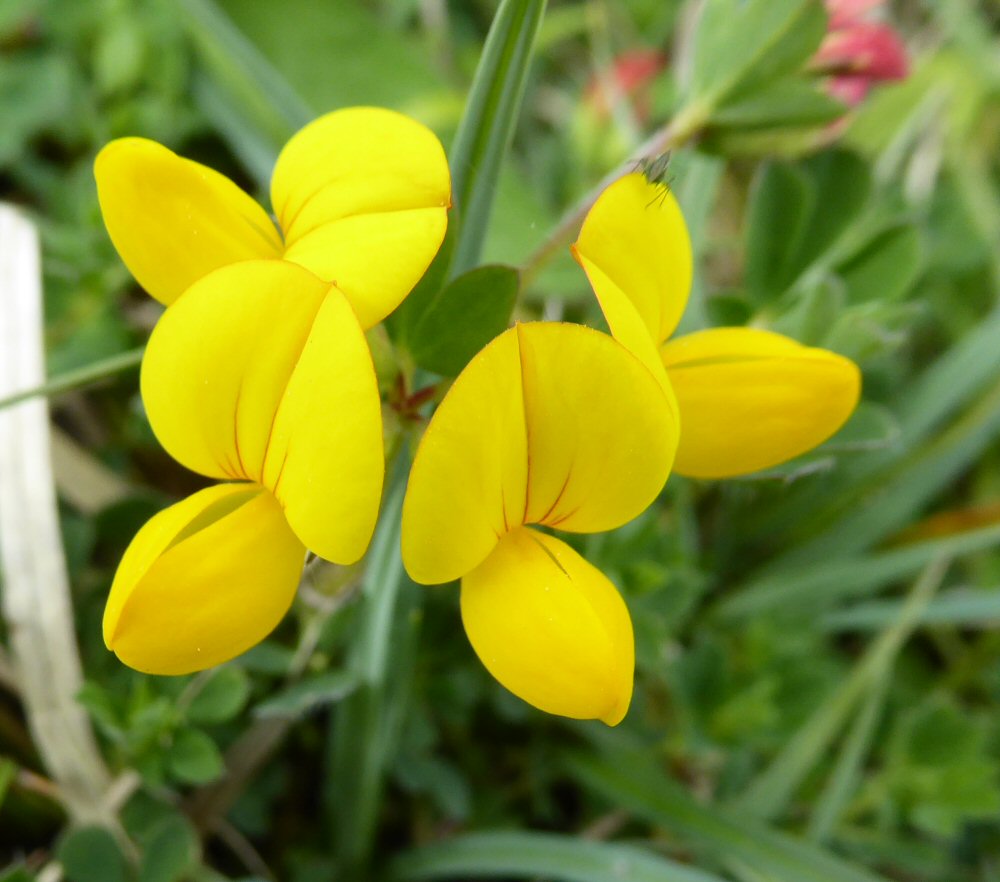
Hawthorn or May is quickly changing the green trees to white.

Sunshine and Success
Friday, May 17th 2019
Lark and Taurus have been relaxing in the shade of their favourite Hawthorn tree during the past two days.

It's a tough life! A bit of paddling in between napping and grazing!
They have had company in Plover's Pool recently from a family of Lapwing with young chicks. Bird watchers also saw a young Tawny Owl in the woodland which had recently fledged. The pool of volunteers is ever growing and the skills and knowledge that people have are incredible. From identifying tracks in mink rafts to repairing owl boxes and caring for the classroom tadpoles! The toad tadpoles have started to grow their back legs and at this stage they are released back into the wild.
Oliver is now quite adept at catching the right ones!
After a morning's work strimming and mowing, volunteers helped to monitor some of the large nest boxes on the reserve. Bob was lucky enough to hold this Barn Owl while the nest was checked. It was an adult female that had been ringed at Foxglove before.
Nearly all of the one hundred small nest boxes have been checked now and many of the garden birds have successfully reared good clutches of chicks such as this Coal Tit chick which was one of eight.
Great Tit chicks have already been ringed and today the first clutch of Blue Tit chicks was ringed too. They all appear to be well fed and in good health.
This has been a huge task, helped by volunteers who have been finding the boxes from the map and scribing the data too.
The boxes are spread around the one hundred acres and visiting each one means going off the beaten track. Whilst out in the woodland this picture was taken of the recently thinned conifer block from the opposite side of the footpath.
As can be seen by the number of ferns this is yet another success story for the reserve.
Spring Flower Walk and Species Recording
Wednesday, May 15th 2019
The weather was perfect for today's Spring Flower Walk. A keen group of visitors, led by Elizabeth, headed out to identify as many flowers as possible on the reserve. One of the first stops was the recently thinned area of conifer where there are already signs of wildflowers growing in the new glades.
Another place of botanical interest was the heathland where heather seeds have recently been sown in the gaps.
Of course, a Spring Flower Walk had to take in the spectacular Bluebell bank on the moorland!
This really is at its best just now!

Back in the field centre, Team Wednesday were hard at work identifying moths from the trap.

Amongst the catch, which was relatively small, was this beautiful Pebble Prominent. The larval food plant of this species includes willows, sallows and Aspen.

Later, several volunteers also carried out a butterfly transect and it was another great result.

A total of 106 butterflies of the following species:
Brimstone 3
Small White 1
Green veined white 33
Orange tip 14
Peacock 12
Speckled wood 42
Small copper 1
After lunch, staff and volunteers continued to monitor the nest boxes on the reserve. This involved a lot of map reading skills! Many boxes are occupied by Bumblebees this year so care was taken when approaching them!
Finally, as it was a fine day for painting, the main wooden sign received a welcome lick of preserver and some jazzy new white lettering!
Our sincere thanks to everyone involved today. The species recording is so valuable as all of the data is passed on to the relevant County recorders and helps to build the 'big picture' of the state of British wildlife.
More Bluebells, Boardwalk and Bird Boxes
Wednesday, May 15th 2019
The scent of Bluebells is finally wafting over the moorland, these beautiful flowers are an indicator that woodland was here in past times. Alongside the coconut-like smell of the Gorse, it is quite a heady cocktail! This area of Bluebells is expanding each year as a result of bracken management.

Volunteers split into two groups yesterday with one focusing on boardwalk repairs. This time along the green trail through the woodland. Firstly, some rotten planks were removed from a long stretch of walkway.

Then some new ones were fitted in place and some wire mesh was added to make the surface less slippery in wet conditions. This team also helped by strimming and mowing around the footpaths close to the field centre and reapiring some steps on the moorland trail. What would we do without them?!

Whilst one team were busy in the woodland, the other group went to check on some of the small nest boxes around the rerserve. Details of the nests are recorded so that the data can be submitted to the BTO (British Trust for Ornithology).

There seems to be a good take up this year with many boxes having Coal Tit, Great Tit or Blue Tit nests inside. Some still had eggs but most had two day old chicks like the ones shown here.

Thank you to all of the volunteers who helped with these varied tasks, it really makes a difference.
An Interesting Day
Monday, May 13th 2019
Cold soon gave way to warmth as Sophie, Gerry, Colin and Elizabeth set off to check more boxes boxes.
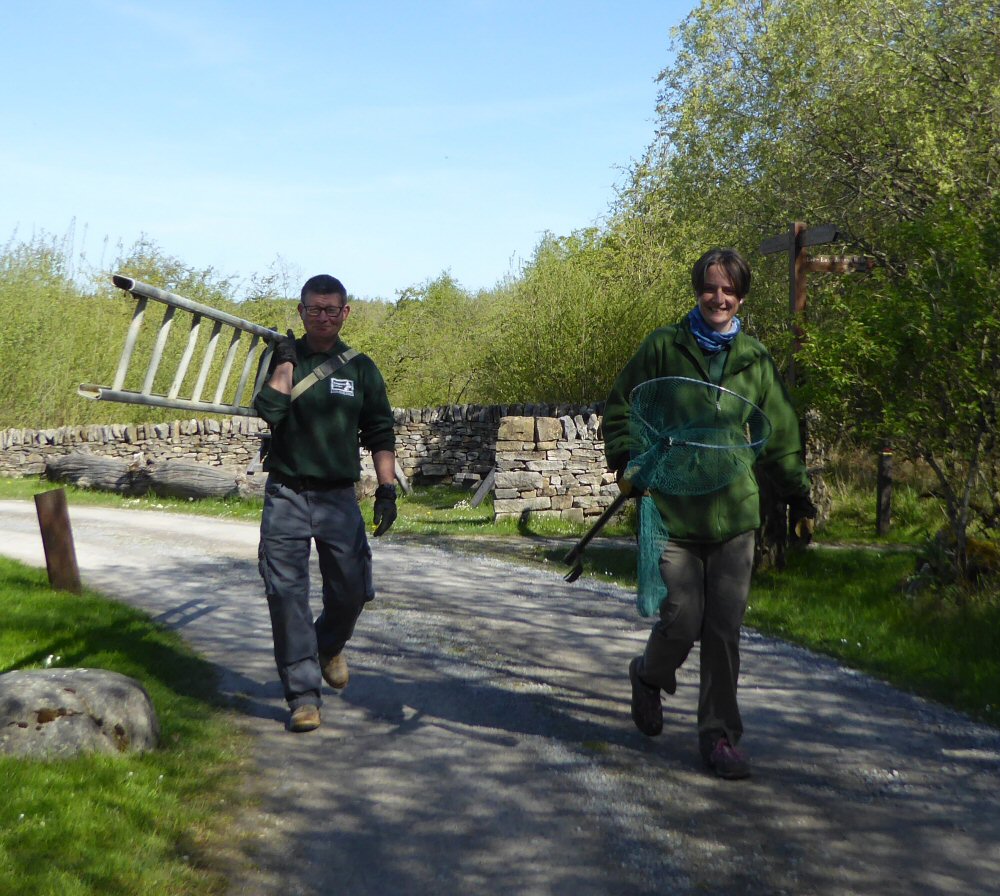
The first box had two chicks. They were ringed and then returned to their nest.
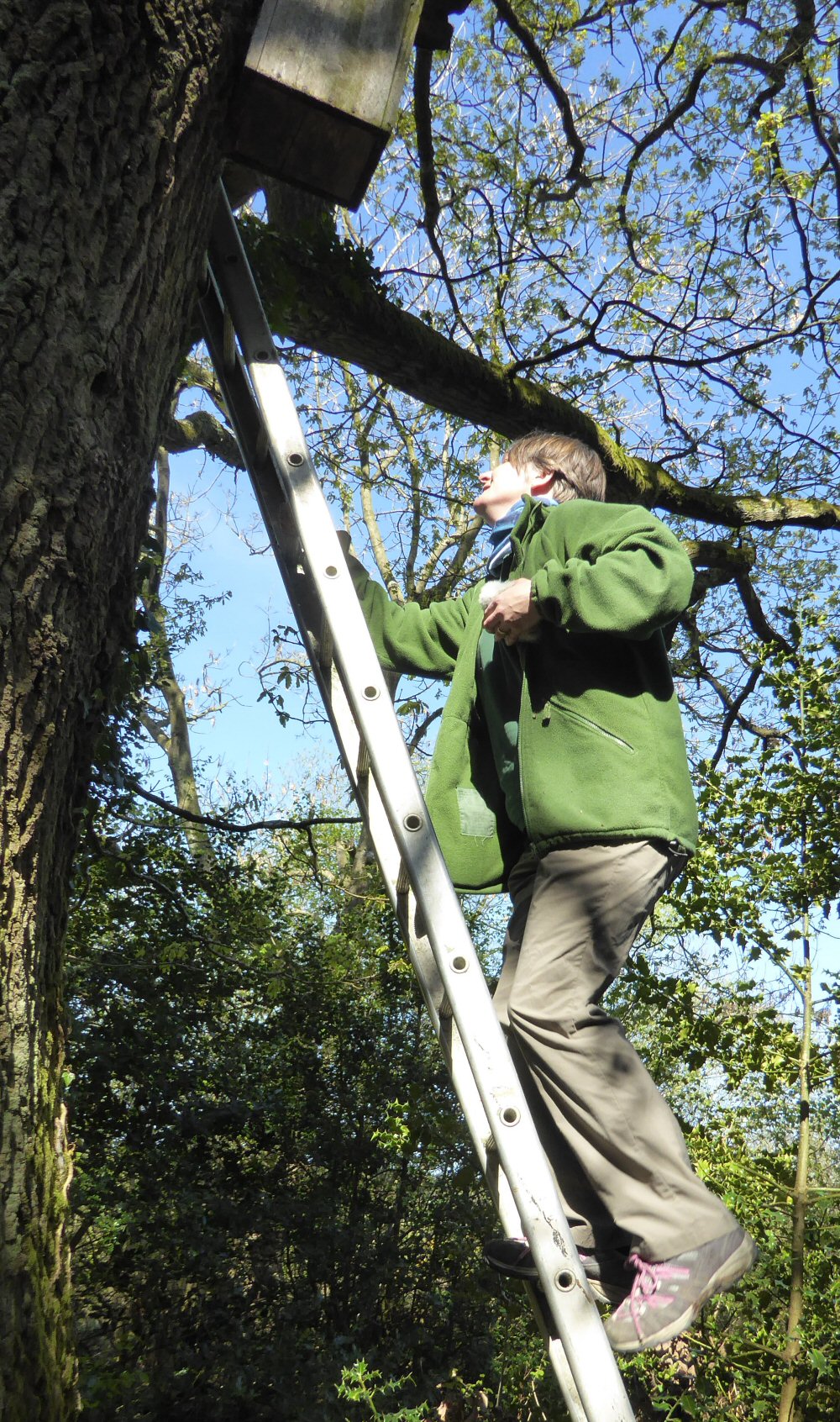
Another box still had eggs, so will have to be revisited. On the way back to the Field Centre, several small boxes were checked. Some tiny chicks were in one and eggs in another. Revisits are already planned.
Next task was to check the ponies on Plover's Pool. Not a single sign of two Exmoor ponies. Had they got lost, moved, or just plain disappeared? Panic!! Another careful look all the way around and there they were, standing behind Plover's Pool, next to the fence, feeding happily. Relief!

Talking to some visitors, we realised that there was a great deal of loud buzzing coming from the bees. They were swarming! We watched as they eventually settled in a tree along net ride 56.
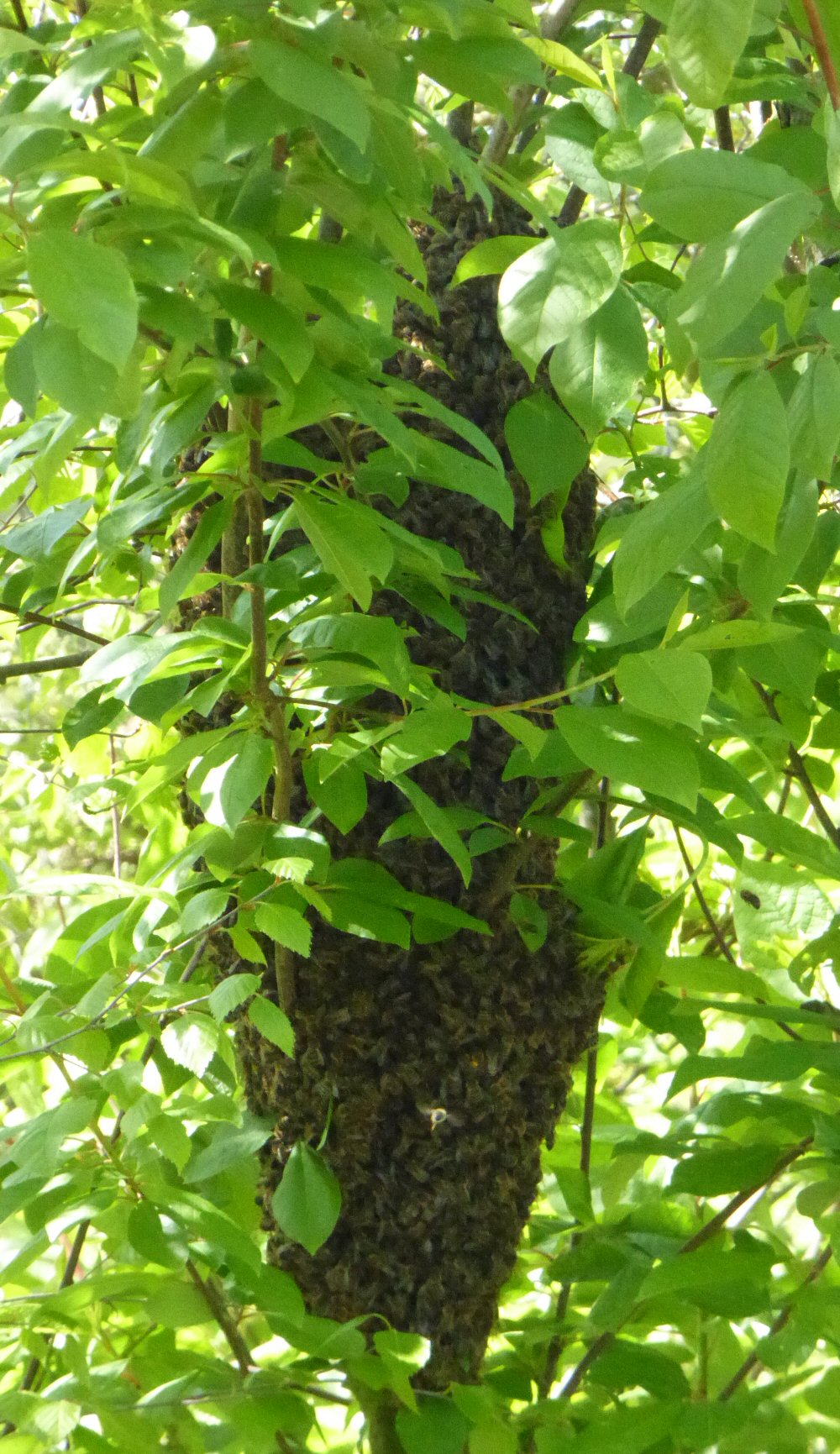
Colonel Alister, one of our bee keepers, came to collect them. Apparently it was a day for bees to swarm as several hives had done so.
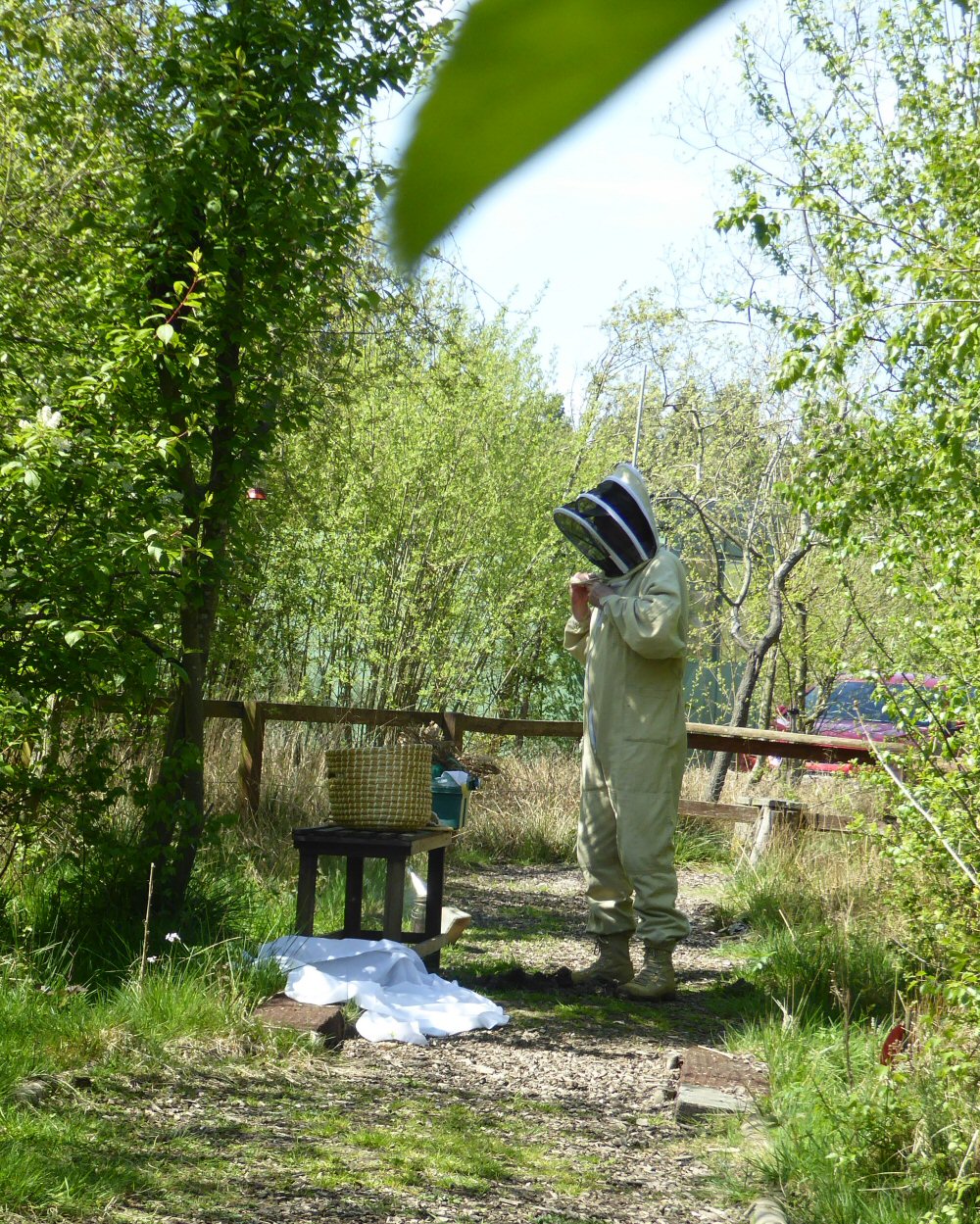
They were brushed into the skelp and then left for some time as many were reluctant to leave the tree and head for their temporary hive. By late afternoon they had all followed the queen into the skelp. We now await the emergence of a new queen, who will leave the hive to go on her mating flight. Once returned she will settle and begin to lay her own brood.
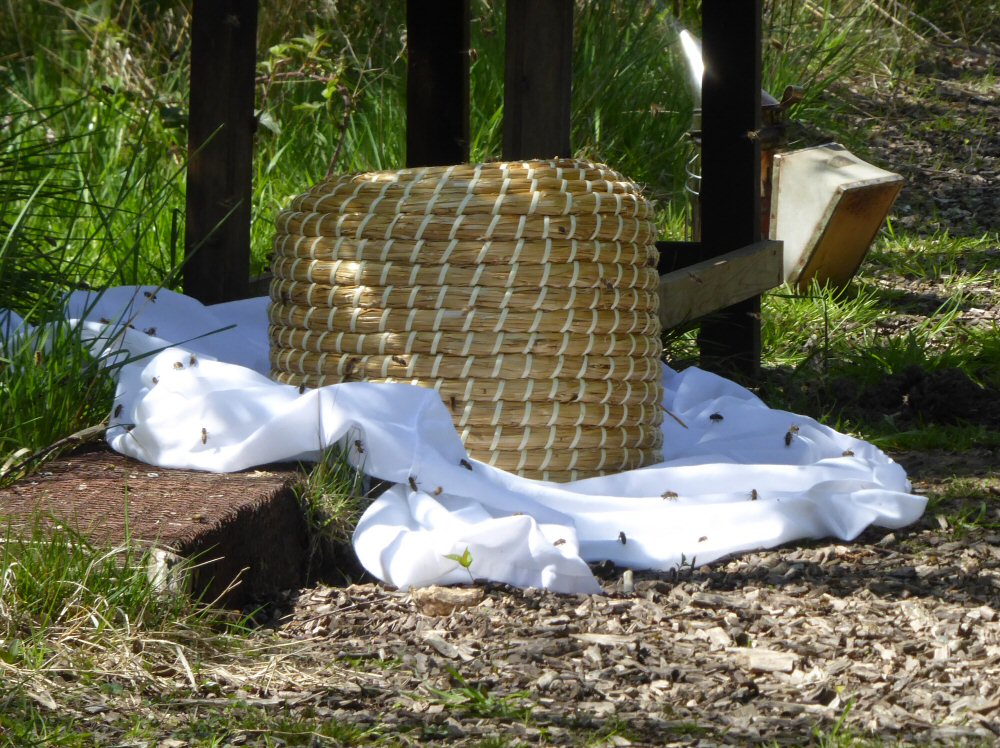
What next was the question we were asking. The remainder of the day was quiet. Large Red Damselflies were on the wing but would not settle for a photograph. Most of the butterflies were also flying quickly. One settled for a short time, but it is almost hunt the white butterfly! It was a Green Veined White.
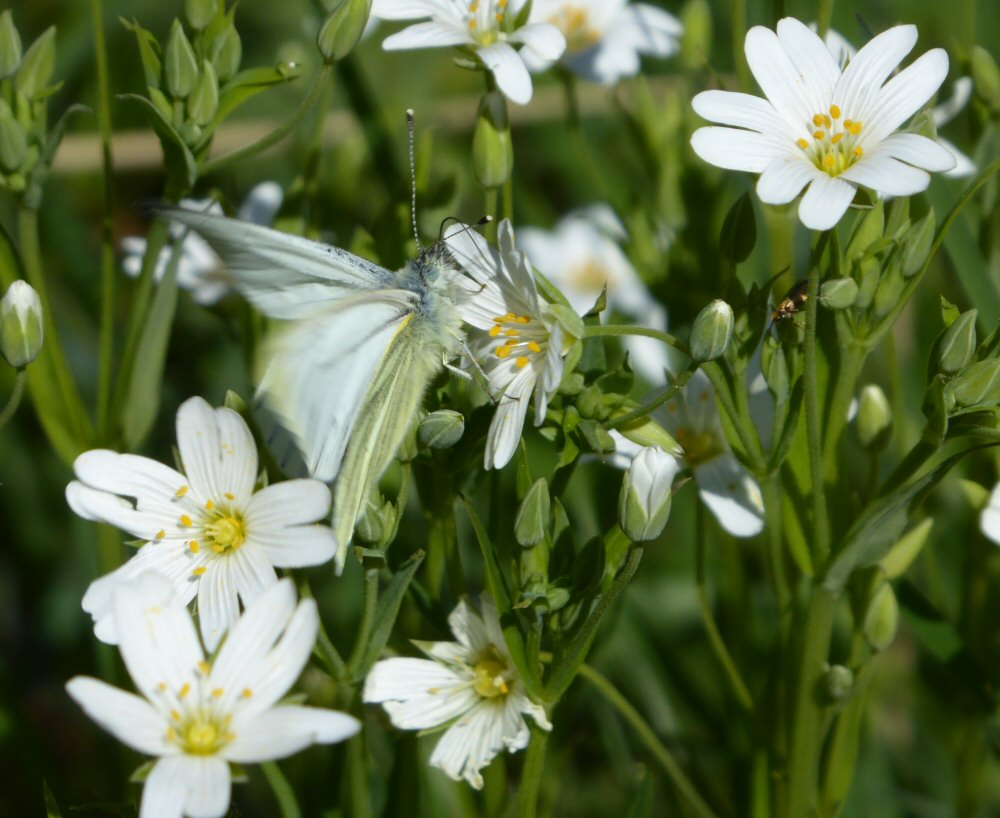
Nest Boxes and Bluebells
Sunday, May 12th 2019
The bird ringers are busy, out most nights checking nest boxes at Foxglove and on the training area. Many Tawny Owl boxes now have the dates noted so that a return visit can be made to ring the chicks. Whenever possible the adults are caught and this often reveals a great deal of information. One Tawny Owl has nested in the same box for several years.
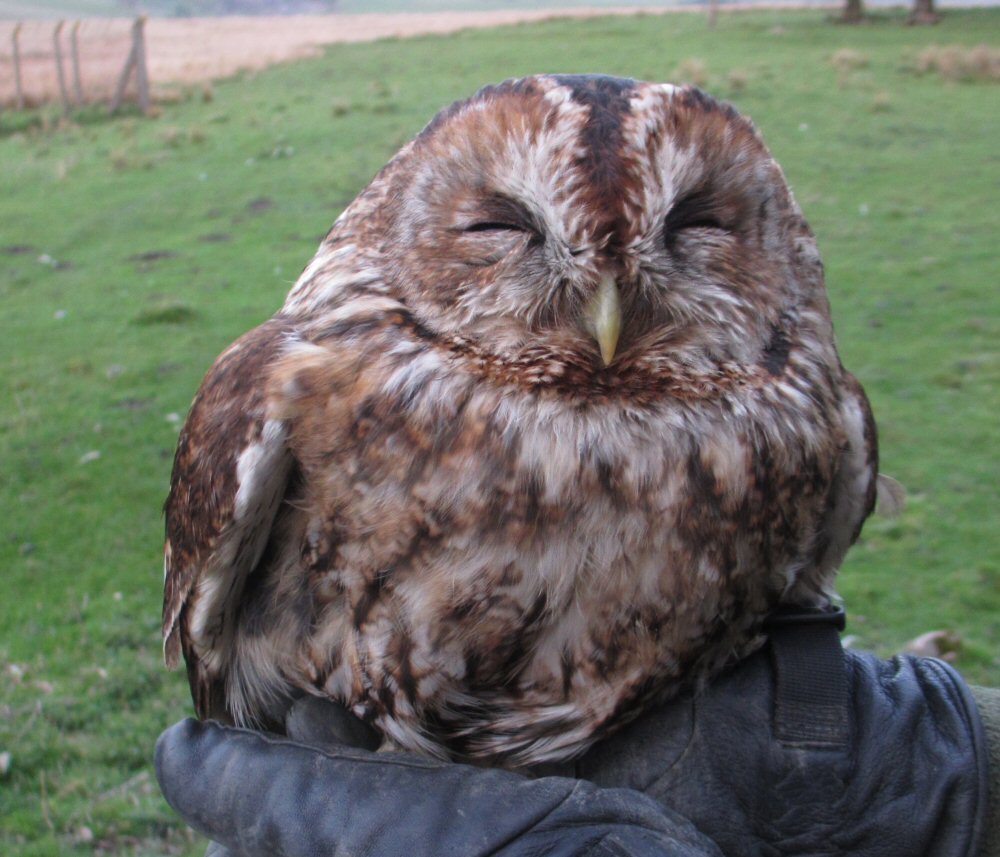
As spring continues it is the turn of the small boxes. Coal, Blue and Great Tits are the main inhabitants. During mist netting we process some of these birds that have been ringed in the nest boxes. In some of the woods around Foxglove, Redstart and Pied Flycatchers can be found nesting.

Many of these woods are home to carpets of Bluebells.
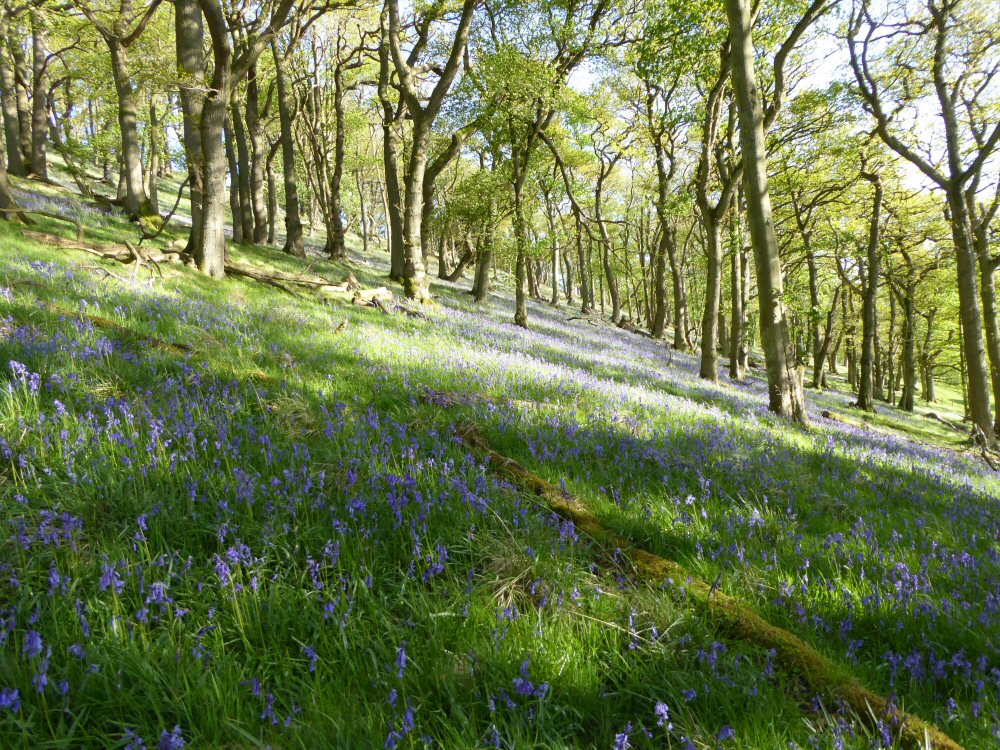
It is native only to the lands fringing the Atlantic and so was not mentioned by the early English herbalists who based much of their work on the Greek and Roman botanists, who were unfamiliar with this beautiful flower.
It is illegal to dig up any Bluebell bulbs. Recent scientific research has shown that trampling of the leaves threatens the survival of the Bluebell. It can survive without its flower but once the leaves are crushed, it is unable to make food.
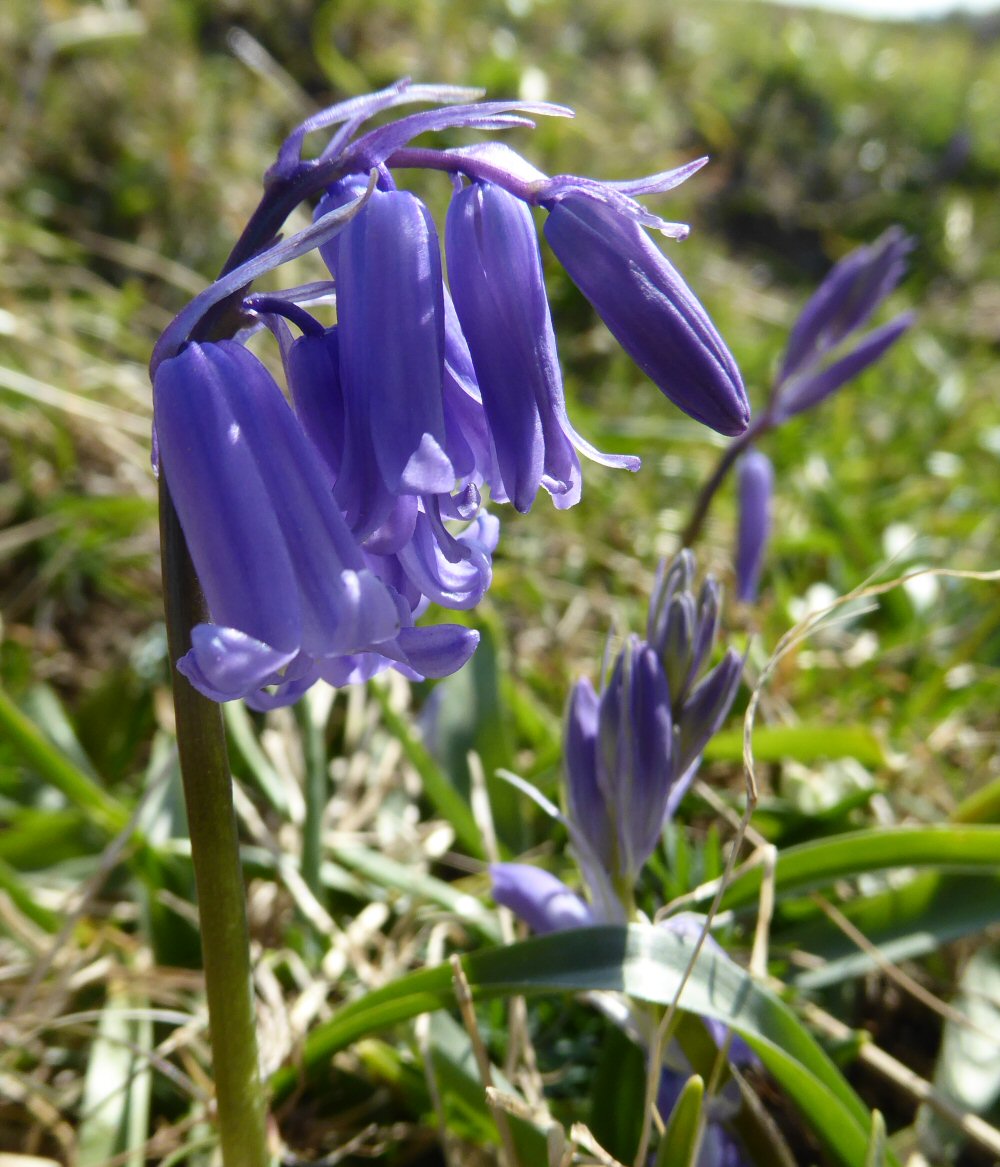

May Flowers
Friday, May 10th 2019
We have mentioned several times this year that we do not know the full impact the Beast from the East, followed by the hot dry summer, will have on the flora and fauna. Looking back to May last year, several flowers were photographed, that as yet have not shown their faces this year.
Bogbean is a beautiful flower and the pond in the Scrapes is now flowering well.

Bugle is just beginning to flower. Although winter cold kills the stems of this plant, wherever it has touched the ground and rooted a new plant is formed.

Walking around a pink/purple flower can be spotted through the new spring green vegetation. This is Bitter Vetchling, which just to confuse things is also called Bitter Vetch, but it is not a vetch! According to one source it is widespread but not common in Britain.

Rainy Days
Thursday, May 9th 2019
Wednesday and Thursday have been exceptionally cold, wet and windy for the time of year. Lark and Taurus were grateful of a little extra food; only a handful of hay each as they are extremely hardy, it was just to 'cheer them up' and to get up close to them to check they were okay! As can be seen, they are in fine fettle, just a bit bedraggled!
In the warmth of the field centre, volunteers have been working away to sort and organise the photographs that are used in displays.
They also identified and recorded species…
...and set out a sales table with second hand Natural History books.
Team Thursday braved the wet weather as some jobs are 'good to do' in the rain (honest)! Stone for footpaths definitely binds together and compacts down more when it is a little wet.
Several trailer loads were emptied out on a short section of trail close to the centre before being raked out and compacted down with the wacker plate.
After a strenous morning, the rain finally stopped so the team went to check the last few large nest boxes from the Adopt-a-Box Scheme to monitor them. There are a few with breeding owls in (both Barn Owl and Tawny), one with a Kestrel and several with Jackdaws. These Jackdaw chicks were just hatching out in their cosy box!
Members of the Swaledale Ringing Team are in the process of checking around one hundred large boxes and so far the owl breeding season is around three weeks behind where it has been in previous years. Eggs seem to have been laid late and chicks are developing more slowly than in previous years. One theory is that the 'Beast from the East' followed by a hot summer killed off the small mammals and therefore there is little food available for the owls, explaining perhaps why many are being observed locally out hunting in the day time. More owl photographs to come over the next few weeks!
Blackthorn, Bridges and Bonfires!
Wednesday, May 8th 2019
Conservation volunteers were hard at work again yesterday. The first job of the day was to install the bridge made on the last 'worky' day to replace one that was 'beyond repair'!

The next job on the list was to prune back a Blackthorn hedge that was hanging over one of the pathways. The small area was first checked for any nesting birds before protruding branches were carefully cut back. The large thorns on this tree make it a difficult one to work with and thick gloves are essential.

As usual, many hands made light work and within no time at all, the brash was loaded onto the trailer and removed.

With the fire risk low after the recent rainfall, it was decided to burn the brash at a designated fire site. There were many jokes about 'burning bridges' as the old timbers were added to the fire!

Once this was finished, the team moved back indoors to the comfort of the workshop to start building a new bridge and repair some old owl boxes. The new boxes were taken out and put up for next years breeding season!

Thanks to Team Tuesday, a few more jobs can be ticked off the list!
CES 1
Monday, May 6th 2019
As the new year dawns, so the cycle of nature begins. Winter is left behind and the reserve turns from blacks and browns to the varied greens of spring. Primroses and Dog Violets show themselves as spring develops. Orange Tips are on the wing. Winter migrants leave and summer migrants arrive. And just as spring moves on so May sees the beginning of CES - the Constant Effort Scheme run by the BTO. The same nets have to be raised for the same length of time on the same days each year.
The 27th year of this scheme started at Foxglove on Sunday, at 6am. It was very cold but no wind as there had been on the day before. The birds woke slowly but their songs soon filled the reserve. At this time of year the bird population is usually halved, as the females are sitting on nests. For the first CES it was quite a busy day. We also ringed our first juveniles of the year, some Robins. You can see it still has its large gape and tiny tufts of down.

Siskin, Bullfinch, Willow Warbler and Chiffchaff were amongst the 23 species of birds processed. Blackcaps had been heard around the reserve and we ringed our first of the season.

The bird ringers were supported by several volunteers who do not ring; from inputting data, checking ring numbers, cleaning bird bags, carrying ladders, scribing…

...to making tea, washing and tidying up! All of this support helps the day to run more smoothly and is greatly appreciated. A special shout for Linda who provided tasty tea cakes too and who celebrated her birthday yesterday, Happy Birthday Linda!

We have seen Mallard ducklings on the wetland, via the camera. There is now, at least one duckling on the lake.
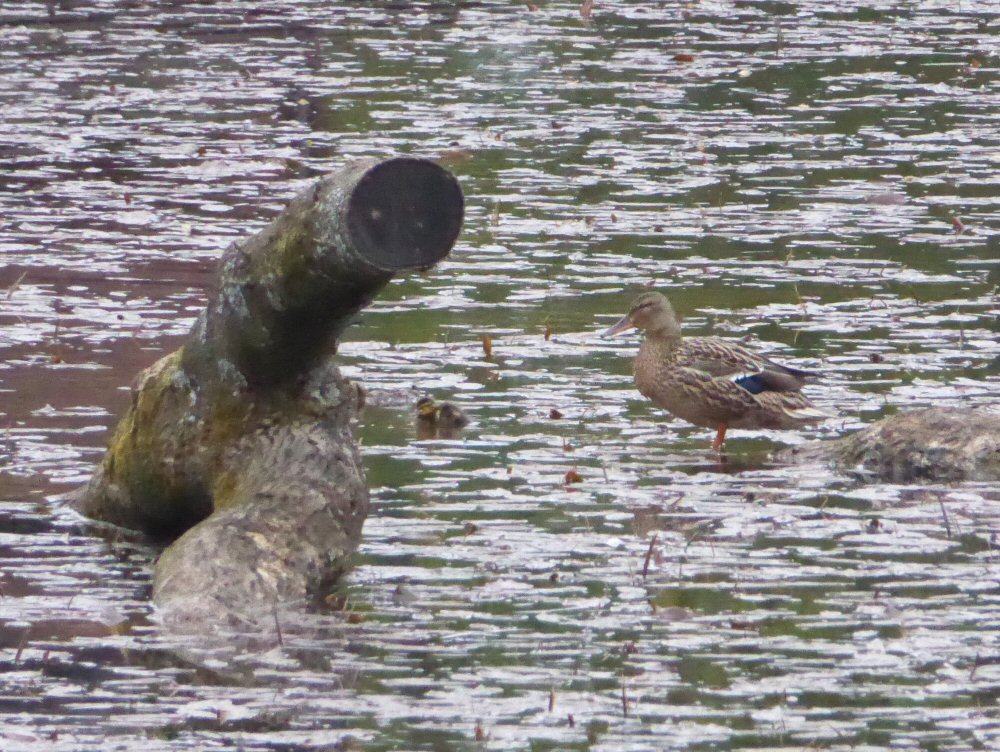
And finally. I have been trying to take a good photo of a Cuckoo Flower showing its light pink/purple colour, but most have ended up white and totally washed out. Another one was going to join the long list when I realised that it would not, because there in the middle of the flower was an orange egg. The Orange Tip butterfly had been out on the flower meadow on the moor.

Unco-operative Moths - Co-operative Flowers
Saturday, May 4th 2019
We always check the flight season of those moths we catch for the first time in a year. Wednesday was the 1st of May and we suspect some of the moths we caught knew the date as their flight season began in May! Although we can't ID every moth immediately we usually can work out where they are in the book and narrow it down until we argree on the correct name. We caught one and eventually looked through every moth in the book, but it did not fit with any of those that we knew. Eventually we agreed that it was a Tissue moth, but the map showing its distribution indicated that it was not in our area. One positive piece of information was that the caterpillars food source was Buckthorn and Alder Buckthorn, which is growing well throughout the reserve. So the next step was a photograph in the container. These are not the best of photographs but are good enough for an ID, to send to Dr Fletcher the moth recorder for VC 65.

His emailed reply confirmed our ID and he said that it was the first sighting in the 10K square. Another new species for the reserve.
An earlier blog mentioned that moths do not always co-operate whilst having their photos taken. The Tissue moth decided to take flight as soon as the container was opened. Another moth decided that it would sit perfectly for us, the only problem being that it did not open its wings! However sitting this way you can see its long antennae and stripey legs!
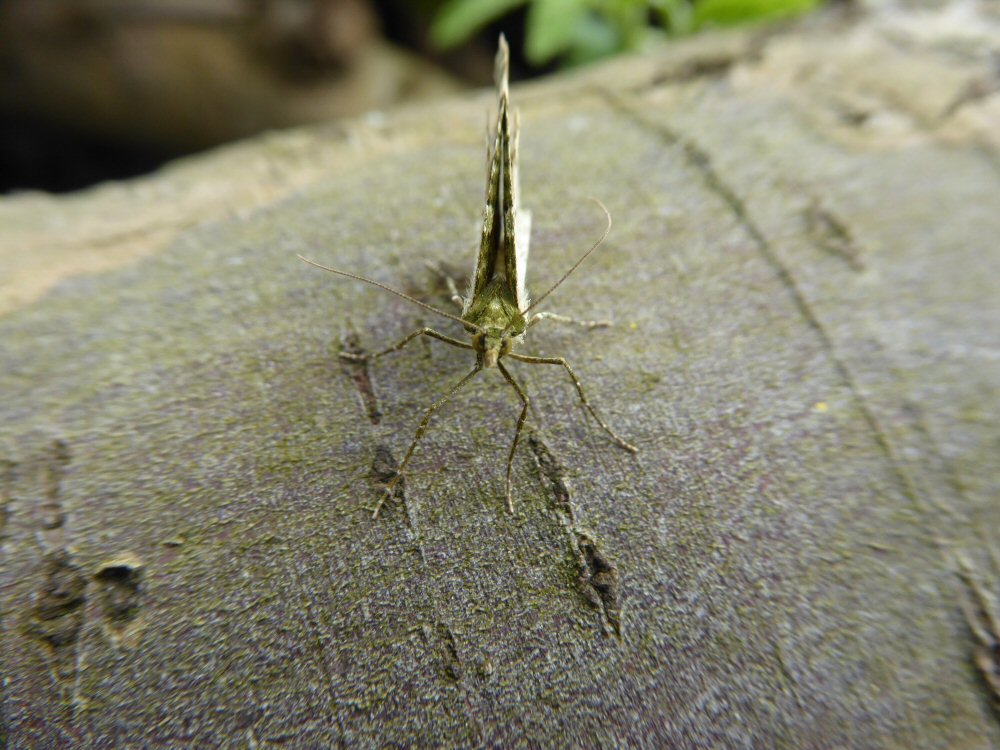
Flowers are more co-operative. Bogbean is just beginning to flower in the pond in the Scrapes.
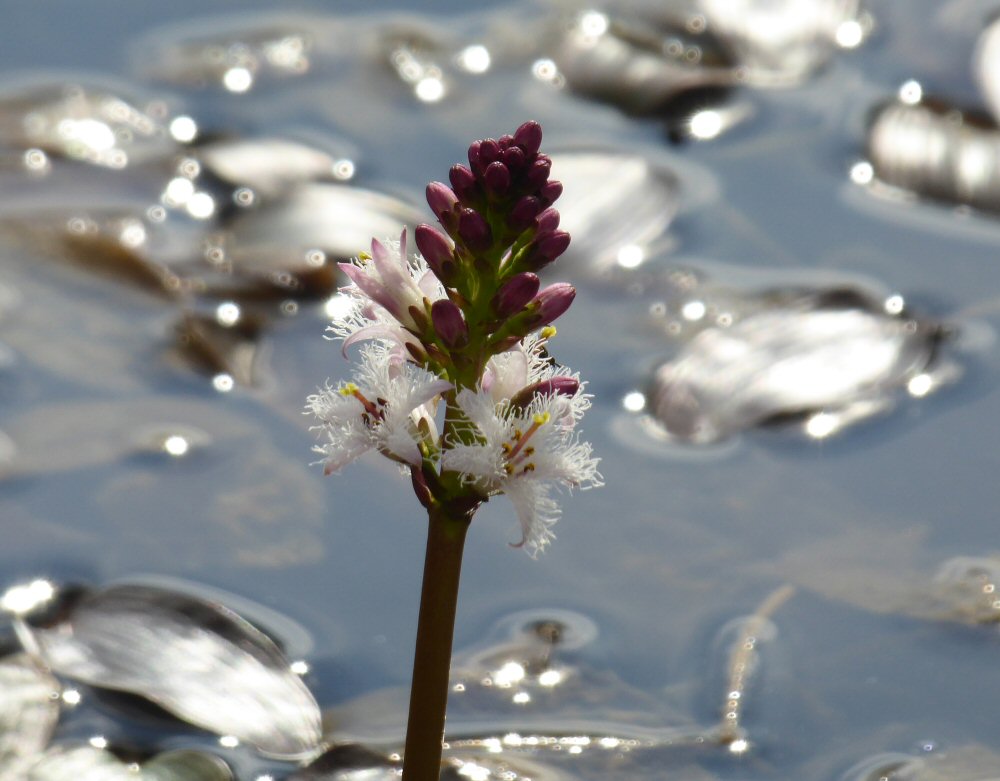
The Crab Apple at the head of the Scrapes is also coming into flower. There were tiny pink petals and buds on the ground beneath it. Bullfinches have probably been feeding on them.
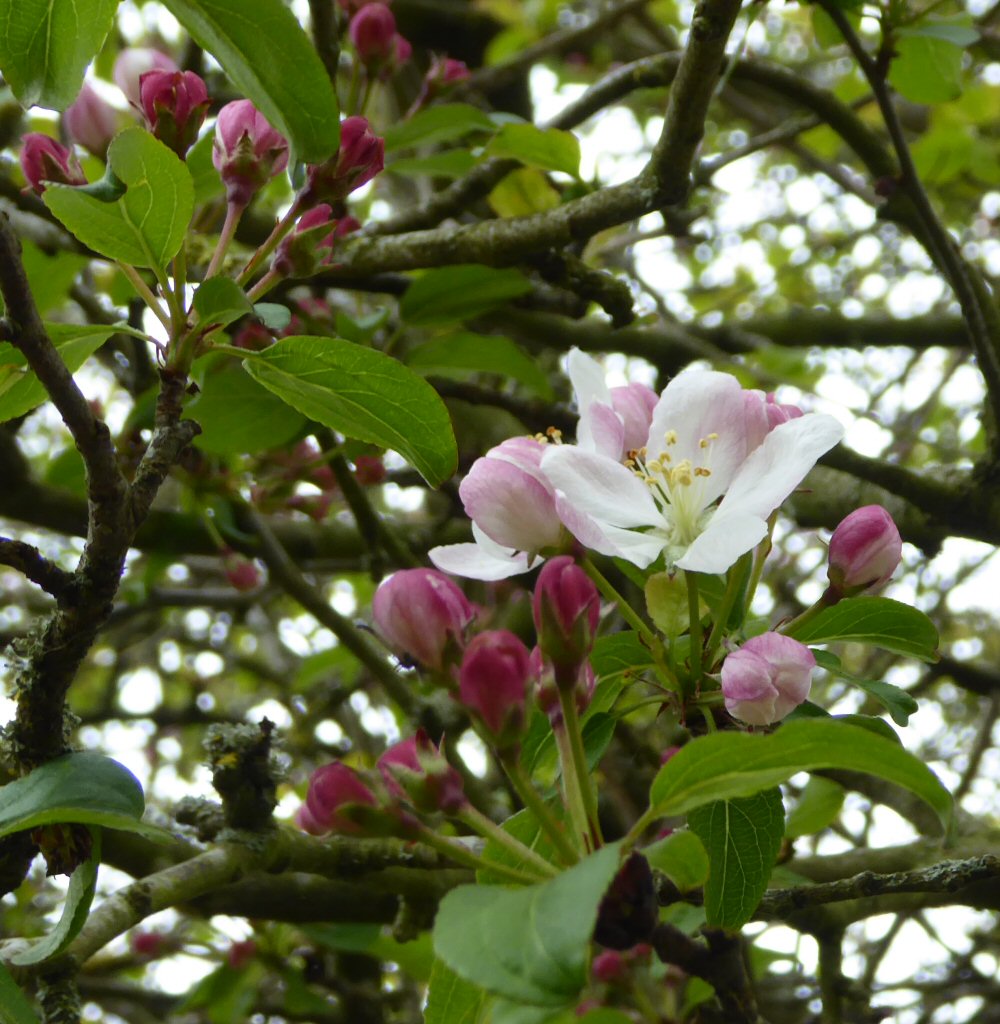
Owl Breeding Season
Friday, May 3rd 2019
Owls are one of the first birds to breed in this area and so the bird ringers are busy monitoring the one hundred plus large wooden nesting boxes on the training area that surrounds the reserve. The adult birds are checked first to see if they have already been ringed, if not then they are fitted with a BTO (British Trust for Ornithology) ring on their right leg. They are then aged and sexed and the data is all recorded for the BTO before they are carefully returned to the nestbox.

The most common owls apart from Barn Owls are Tawny Owls. Although they don't seem to move very far from where they were born (An adult Tawny retrapped on Thursday night last week had been breeding in the same box since 2009), other information can be gleaned from ringing them. Longevity is one example and some of the Tawny Owls that are ringed by the Swaledale Ringing Team are older than thirteen years.

Once the adults have been ringed then the nest is checked. In many cases, the ringers need to return again a few weeks later. However, this year some already have large youngsters like this healthy trio below.

All of this is hard work, involving a lot of logistics, a tall ladder, some thick gloves and a good head for heights!

Back at Foxglove, the preparations for the Bank Holiday weekend continued with the filling of all bird feeders. There seems to be a lot of activity at the moment so maybe some song birds are already feeding their young too.
In the ponds, the Toad tadpoles are developing well and are clustering together, most likely for warmth in the cooler temperatures of the last couple of days.
Net Ride Maintenance
Thursday, May 2nd 2019
With the CES (Constant Effort Sites Scheme) bird ringing season about to begin, staff and volunteers focused on preparing the net rides for the coming weekend. During the summer the bird ringers operate the same nets in the same locations over the same time period at regular intervals through the breeding season at over 140 sites throughout Britain and Ireland. At Foxglove this has taken place for twenty-six years. The scheme provides valuable trend information on abundance of adults and juveniles, productivity and also adult survival rates for twenty-four species of common songbird.

With the recent warm weather and rainfall, the rides were in need of strimming, mowing and pruning. Priority was given to the CES rides and then others were tackled too.

This was the perfect opportunity to try out the new, shiny hover mower.

Later, with the mowing complete and rain threatening, it was decided to catch up on a few indoor jobs such as weighing out bird seed.

It wouldn't be a Thursday unless Bob built another bridge! He has six under his belt so far. Many thanks to all of the volunteers who gave their time today.

Finally, the tadpoles in the classroom aquarium have eventually grown some legs! The one pictured below is a Common Frog tadpole. These can be distinguished from Common Toad tadpoles by their speckled greenish brown colour. In comparison, the Toad ones are jet black all over. Both can be seen in separate tanks in the field centre.

Moths and Butterflies
Wednesday, May 1st 2019
Volunteers have been hard at work this week surveying the moths and butterflies on the reserve. This morning, the moth trap was full. This Purple Thorn was a highlight and the first of this species to be recorded in 2019.

Moth identification is quite addictive and even the dull coloured ones often have beautiful intricate patterns. This Early Grey is no exception and as its English name suggests, it is one of the earliest moths to emerge in the season, flying from March to May.

The Water Carpet is another spring flying species which feeds on Bedstraw.

On close inspection, this Pale Prominent, which resembles a piece of broken wood, appears to have a fluffy head and tail! The long abdomen, divided tail tufts and strongly feathered antennae on this individual all indicate that it is a male. The foodplant for this moth is Willow which would explain why it is regularly observed at Foxglove.

A team of enthusiasts meet at the field centre every Wednesday morning to empty the traps and to identify the different species. Most are then photographed which is not always easy!

Butterfly transects are also taking place again now that the weather has warmed a little and yesterday was a perfect day to count the adults on the wing. Catherine counted 82 in total of the following:
Brimstone 4
Small White 6
Green veined white 5
Orange tip 29
Peacock 20
Speckled wood 18
Our thanks to everyone involved with this important information which is passed on to the relevant county recorders. Butterflies and moths are a great indicator of the state of the environment around them. Thank you too to Elizabeth for today's photographs.



































